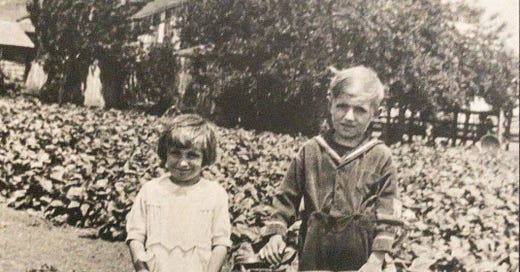Banking on the American Dream in the Prohibition Era
I’ll be the guest speaker at the Italian American Heritage Foundation in San Jose as they celebrate Italy's Piedmonte region on Feb. 15. See details below!
👋 Hello, I’m Kevin Ferguson and welcome to 🍷 Rain on the Monte Bello Ridge,🍷 a memoir about health, aging and winemaking. (Book summary) 🍇 This is my newsletter. It includes book research and early release chapters about winemaker Mario Gemello and his centenarian widow, Kay Gemello. 📖 They are my lovable maternal grandparents. You can subscribe by clicking on this handy little button.
Behind-the-scenes: Questions in one of my late ancestors’ treasured stories gets answered.
How the Bay Area’s Immigrant Community Relied on the Bank of Italy Beyond Just Banking In The Early 1900s
Great Grandpa John Gemello cultivated his winemaking skills in Piedmont, Italy. His formal education was limited to grade school. He learned to prune a vineyard at 13 and run a team of oxen around that same period.
My grandfather, Mario Gemello, similarly got most of his skills on the job, working along side his father at the upstart Gemello Winery in Mountain View. It was launched in 1934, a month after Prohibition was repealed. Mario’s formal education ended the next year, graduating from Mountain View Union High School.
He, too, was taught to be a jack-of-all-trades. A winemaker. A farmer. A homebuilder. In 1941, he built a second house on the Gemello Winery property and documented every building expense ($4,000 in all) in a small blue notebook. Where did he learn to be so meticulous about financial recording-keeping? I turned over this rock just recently.
1922: Grandpa Mario and his sister, Sally, in the Santa Clara Valley.
Another story that refers back to that answer dates to 1930, when the Gemello family business was farming and peddling produce house-to-house during Prohibition.
Santa Clara Valley farmers were hit by a double whammy. The 1929 market crash and the 1930 winter freeze, which wiped out that year’s fruit and vegetable crop. In an old cassette tape (recorded in the 1970s), Great Grandpa John told this story, and said he went to the Bank of Italy (predecessor to the Bank of America) to get a loan. My great grandfather passed away in 1981. For some time, I had been curious about that loan and its accessibility as banks were failing by the thousands during the Great Depression.
But Malcom Harris’ new book, Palo Alto, A History of California, Capitalism and the World, sheds some light on both Bay Area farmers’ record-keeping habits and the relationship between Italian immigrant farmers and the Bank of Italy, whose founder cut his teeth in business as a young produce delivery boy as well.
Before launching the Bank of Italy, A.P. Giannini worked along side his stepfather, filling carts with fruits and veggies in the morning and bringing the load downtown to distribute to small retailers in San Jose.
“[A.P.] established relationships with farmers up and down the state, mailing out cold call letters,” writes Malcom Harris in his book.
“[A.P.] showed an aptitude for business,” Harris writes in his book. “[A.P.] established relationships with farmers up and down the state, mailing out cold call letters. They made small loans to farmers they worked with and offered the company’s knowledge of the urban market to nudge them to make profitable planting decisions.”
Later, after forming Bank of Italy, Giannini aggressively pursued every potential deposit in the Italian immigrant farming community.
And here’s the lesson passed down to my ancestors: Giannini compelled farmers to behave like businessmen, requiring standardized record-keeping from his borrowers. “If you wanted the good interest rate, you had to modernize in ways that made the good interest rate possible,” Harris writes in his book.
This likely explains Grandpa Mario’s meticulous records of his homebuilding expenses.
Depression Era Makeover: Bank of Italy Gets Rebranded Bank of America
After perfecting these banking strategies with the Italian immigrant community, Giannini extended his banking services to other immigrant communities. To do so, he hired bilingual tellers to support these customers throughout the 1920s.1
By the end of the decade, Bank of Italy had the most California Chinese deposits of any San Francisco bank. In November of 1930, Giannini rebranded Bank of Italy as Bank of America.
When the 1929 Market Crash hit, panicking Americans flocked to banks to demand their cash, believing it’d be safer stowed under their mattresses.
In the next two years, nearly 2,000 banks failed.2 However, Giannini was able to keep Bank of America afloat through some savvy maneuvers, including offering financing with interest rates close to zero. Great Grandpa John Gemello took out a loan for two purposes: enough money to live on in 1930 and to purchase a new tractor. He used the tractor in the morning, and rented it out in the afternoon for extra cash.
In 1932, Giannini loaned $6 million to engineer Joseph Strass to finance the Golden Gate Bridge with this condition attached: hire the Bay Area’s unemployed Italian workers for the project.3
Speaking at The Italian American Club In San Jose
Feb. 15th luncheon: I’ll be the guest speaker at the Italian American Heritage Foundation in San Jose. They will be celebrating the Piedmont region of Italy. Come hear me share the Gemello Winery story and the colorful characters behind it.
Reserve your ticket!. Member: $25 Nonmember: $35
Address: 425 N. 4th St, San Jose
Do you like this newsletter?
Then you should subscribe here:
Harris, Malcolm, Palo Alto, A History of California, Capitalism and the World, Hachette Book Group, pg, 34-35
The History Channel Web site, "Great Depression Bank Runs"
America Domani, "From Bank of Italy to Bank of America: Get to Know Amadeo P. Giannini"




